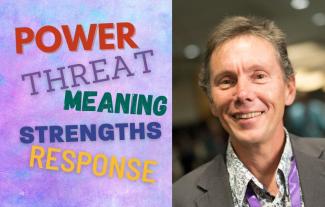The Power Threat Meaning Framework & Stammering

Dr Cameron Raynes introduces the Power Threat Meaning Framework and explains how it can help us to change the way we view our stammers.
I love to be jolted out of the way I see the world. To be given a new lens through which to look at things in the hope of discovering new patterns in the way the world works. I believe that the Power Threat Meaning Framework (PTMF) offers a useful new way to look at stammering. In particular, the mental distress and troubling behaviours associated with it.
What is the PTMF?
The PTMF was launched in the UK in 2018 as an alternative way of understanding mental health, and was developed by a group of psychologists and service users led by Lucy Johnstone and Mary Boyle. Instead of diagnosing someone with mental distress by asking 'What is wrong with you?', the PTMF asks questions that explore what has happened to them — how something from the outside world may have impacted them, and the effects that has had.
In essence, it asks 'What is your story?' and helps people to see that the cause, or 'fault', isn't with them, but rather with something from the outside.
The PTMF is something anyone can use to understand themselves, not just psychiatric patients. In relation to stammering, the PTMF gives voice to what we know deep inside — that the 'problem' of stammering lies not in us, but in the fact that we live in societies in which disfluency is seen as 'bad', a deficit that we are being constantly reminded of.
My experiences
What is it like to stammer? Consider this:
I thought I was a 'normal' kid. The world was wonderful. I had friends, I was excited to go to school each day. I was eight years old.
Then, the most terrible thing happened. Standing in front of my classmates — all the friends I had in the world — my mouth opened and closed, and nothing came out. F-f-f-f-forcing out w-w-w-words, my face contorting, I was filled with shame and terror as I suddenly realised I couldn't speak as others could. I went home in tears, inconsolable. Turns out I wasn't like everyone else. I couldn't talk 'properly', and it seemed I was the only one cursed in this way.
I withdrew into myself. Despite being as smart as anyone in the class, I rarely put my hand up to answer a question. I felt shame and terror every time I was made to stand in front of the class and read something out. I had more sick days than anyone else in my class. I felt like the ugliest person in the world.
I was now nine years old.
My stammer grew in my mind. At times it seemed to be the only thing I thought about. I reached adulthood and never told jokes because they require … timing. I rarely told stories because they put me at the centre of attention and required an ending. I had much to say but often stood by silently, watching and listening, as the people around me stated their opinions, engaged in conversation, gossiped, traded light-hearted insults — in short, did all the amazing things that language makes possible; all those things that allow a person to stake a claim to their rightful place in the social hierarchy that surrounds them.
What followed was three decades of being vigilant... of choosing my words carefully and not taking up social space.
What started out as a simple neurophysiological glitch that affected the coordination of my mouth, tongue, vocal cords and breathing became a full-blown pyscho-social condition that affected just about everything I did.
What followed was three decades of being vigilant, making sure I didn't slip up in public. Three decades of choosing my words carefully and not taking up social space. Three decades of avoiding employment that I thought would require too much talking. In restaurants I ordered the meal I could say rather than the dish I wanted to eat. I suffered panic attacks, an anxiety disorder, intermittent mild depression, insomnia. I didn't give a speech on the day I got married.
Though I stammered from the time I could talk, the psychosocial aspects of stammering began when I was eight, when my sense of self was still forming, when crucial connections were taking place in my brain. It was a trauma that played out daily, for decades.
Mental distress & stammering
Research confirms that mental distress is closely associated with stammering (For one example, see Adriaensens, Waes, & Struyf (2017)). And why wouldn't it be, for a social species like Homo sapiens, for whom whole cultures are built around the notion of 'saving face' and an emphasis on status, reputation, personal mastery and honour? To not be able to speak feels like a constant existential threat, as if you have been reduced to an animal that grunts.
And this is where the PTMF comes into play. In simple terms, the PTMF is based on the idea that mental distress operates largely from the outside in, not from the inside out. This honours the sense we have that mental distress has causes and meanings; it has context. The PTMF works on the assumption that everyone's experience makes sense; their mental distress is an understandable response to the circumstances they find themselves in. It has been applied to thinking about the understanding and treatment of mental distress among various groups including prisoners, mental health support groups, survivors of domestic violence, and people experiencing grief.
In simple terms, the PTMF is based on the idea that mental distress operates largely from the outside in, not from the inside out.
Under the PTMF, mental distress is an understandable effect of exposure to a perceived threat, with this threat stemming from a perceived powerlessness. It's a normal response by the body and mind, and the stories the world tells about us — and that we tell about ourselves — can increase or decrease this distress.
For us, this threat comes from the negative reactions and attitudes we face from others when we stammer. The PTMF's message is this: 'You are experiencing an understandable and indeed adaptive reaction to threats and difficulties. Many others in the same circumstances have felt the same and would react the same way you have' (Johnstone 2022, p. 23).
As mentioned at the beginning, in contrast to traditional psychiatric approaches which revolve around the question 'What is wrong with you?', the PTMF operates according to the following key questions:
- 'What has happened to you?'
- 'How did it affect you?' (These top two ask about the 'Threats' and their power: how does/did it threaten you?).
- 'What sense did you make of it?' How did it make you feel? (The 'Meaning').
- 'What did you have to do to survive? (Your response to the threats).
(Johnstone & Boyle 2018, p. 190).
In a presentation I gave at the STAMMAFest conference in Nottingham this August, I discussed these one by one, showing the remarkable relevance that the PTMF has for understanding the causes of the mental distress of stammering.
For instance, the threat of stammering ('How did it affect you?') is entangled with the common feeling that when we stammer, something of our core, our essence, is on show: an essence that societal narratives have judged to be synonymous with lack and clumsiness or, even worse, cowardice and fear. This is a deeply unpleasant experience and can happen many times each day. For me at least, it felt like I was being turned inside out every time I stammered, so that everyone could see my feelings, the thing I feared, the thing which could bring me undone.
Using the framework can empower us as people who stammer to see that we are not to blame.
Ramifications
The PTMF suggests very interesting and useful areas of research and ways forward. With its commitment to seeing humans as 'active, purposeful agents, creating meaning and making choices in their lives' (Johnstone & Boyle (2018, p. 6), the PTMF has ramifications not only for how we see ourselves, and for speech & language therapy, but for activism too.
Using the framework can empower us as people who stammer to see that we are not to blame. It can reduce the stigma we place on ourselves, as well as societal stigma.
Consider the four questions I've listed above. On top of those, ask yourself 'What are my strengths? What 'power resources' do I have access to? These might be our willingness to engage with each other and our allies to build communities of support, including self-help groups or organisations such as STAMMA.
The PTMF explicitly makes a connection between mental distress and social justice, for it understands that circumstances and context are at the root of mental distress and must be tackled if the distress is to be alleviated. Just as the feelings of shame that often accompany being homeless cannot easily be resolved without the provision of housing.
Know this — if you have experienced distress as a result of stammering, you are not alone. You are not to blame. It's no reflection on you as a person; on the contrary, it is a reflection on the premium placed on verbal dexterity, on fluency, by societies and cultures throughout the world.
If you would like to read more, The British Psychological Society website includes an excellent section on the PTMF, including videos, fact sheets, training materials, and news of how the PTMF is being used in a range of settings by practitioners around the world.
Dr Cameron Raynes teaches creative writing, literature and Aboriginal history at the University of South Australia. You can email him at cameronmurrayraynes@gmail.com
References
Adriaensens S, Waes SV & Struyf E (2017), Comparing acceptance and rejection in the classroom interaction of students who stutter and their peers: A social network analysis, Journal of Fluency Disorders, vol. 52, pp. 13–24.
Johnstone L & Boyle M (with Cromby J, Dillon J, Harper D, Kinderman P, Longden E, Pilgrim D & Read J) (2018). The Power Threat Meaning Framework: Towards the identification of patterns in emotional distress, unusual experiences and troubled or troubling behaviour, as an alternative to functional psychiatric diagnosis. Leicester: British Psychological Society.
Johnstone L (2022), General Patterns in the Power Threat Meaning Framework — Principles and Practice, Journal of constructivist psychology, vol. 35, no. 1, pp. 16-26.

































